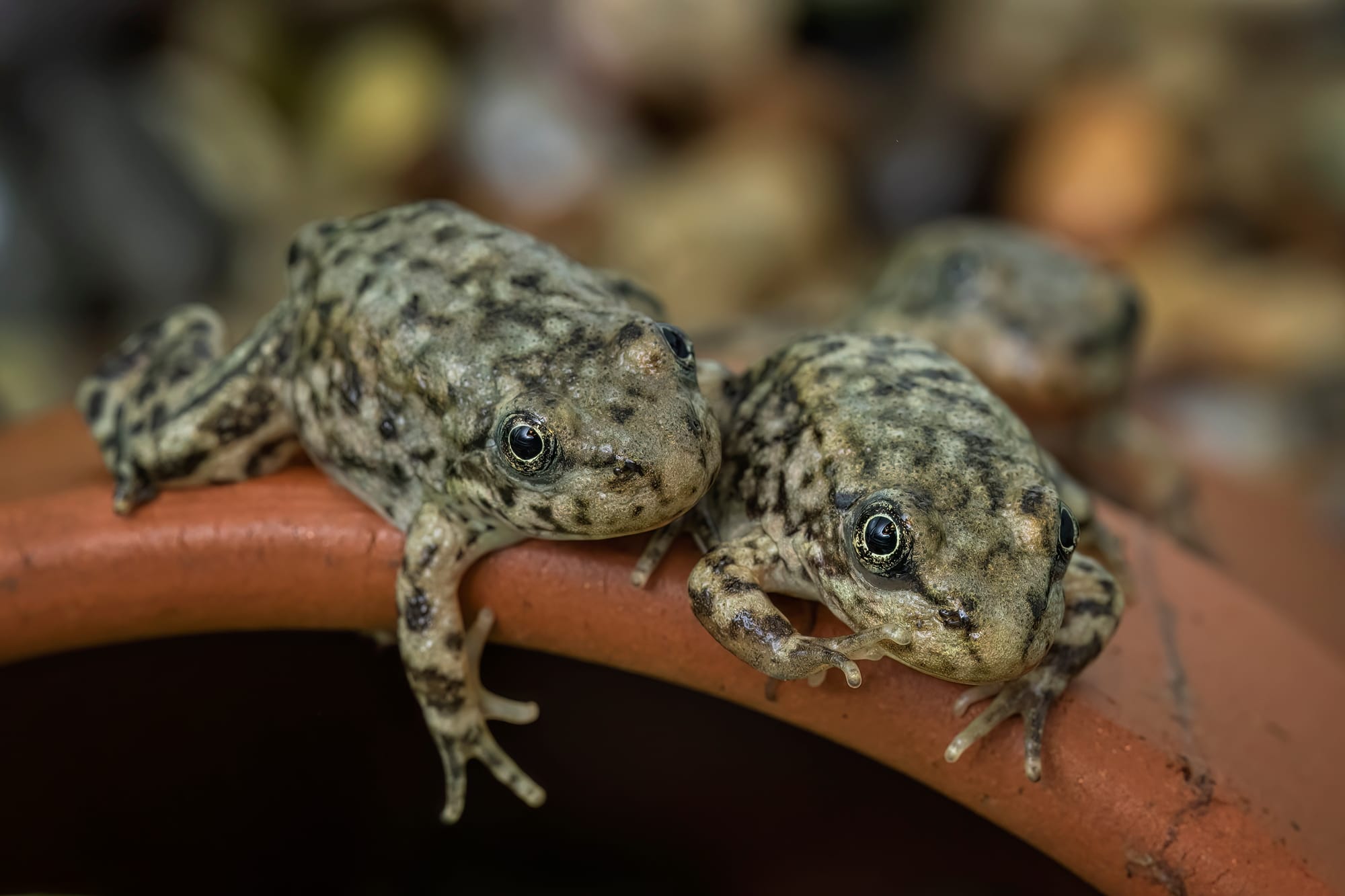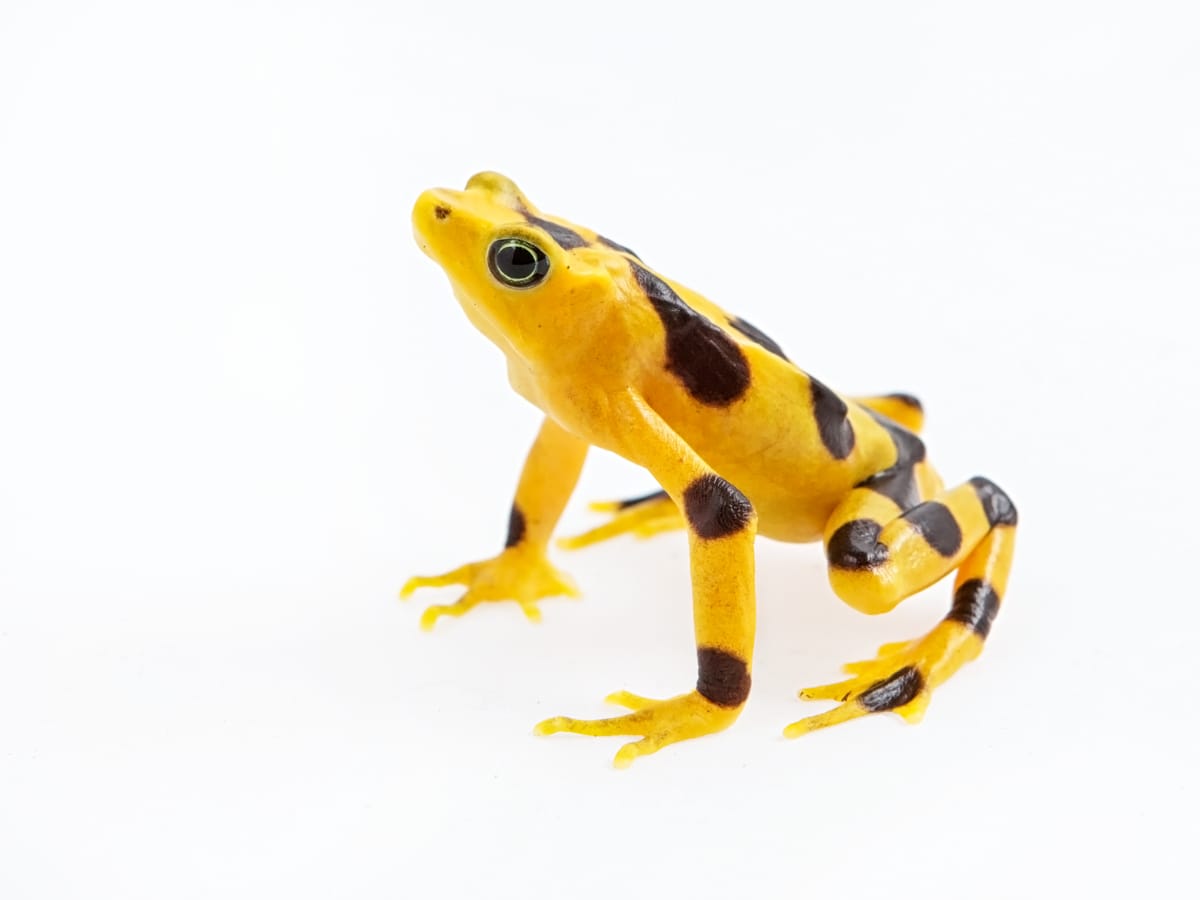Erin Lundy hasn’t always loved frogs. The Hawaiʻi-born biologist and animal care expert had more of a soft spot for marine mammals and in 2018 began working with otters and seals at the Aquarium of the Pacific in Long Beach, California. “They’re very cute, charismatic, and smart,” Lundy told me. Frogs may be cute, she added, but they’re not known for their smarts.
A couple years into her work in Long Beach, the aquarium needed help with amphibian conservation. A coworker asked if Lundy liked frogs. She replied: “Yeah, enough.”
Against all odds, she came around on amphibians. At first glance, a palm-sized tattoo of an otter inside Lundy’s forearm backs up her professed love of mammals. But there’s a surprise in the tattooed otter’s grasp: a tiny, colorful mountain yellow-legged frog. “It turns out I really like frogs,” she said.
Lundy became captivated by how in tune frogs are with their habitat. Amphibians have porous, permeable skin that sensitizes them to all the chemicals and conditions of their environment. “They like stability — they don't like super hot, super cold,” Lundy said. “They’re incredible indicator species of what the health of our environment actually looks like.”
The mountain yellow-legged frog tattooed on her arm is a perfect example. One hundred years ago, you could hardly take a step along California’s alpine lakes without noticing mountain yellow-legged frogs. Plop. Plop plop. Plop. The platonic ideal of a frog. Field biologists Joseph Grinnell and Tracey Storer wrote at the time about their numbers — “the commonest amphibian in most parts of the Yosemite section” — and the skittishness that sent them plopping into the water. By the 1990s, numbers collapsed. A 1996 field survey retraced Grinnell and Storer’s steps, and reported declines of several species. The researchers blamed trout.
“They’re incredible indicator species of what the health of our environment actually looks like.”
Californians had introduced trout to alpine lakes to support recreational fishing throughout the 20th century; Yosemite’s park rangers would stock one million per year, according to a 1940 guidebook. The problem is, some lineages of mountain yellow-legged frogs had never seen a predator. In the absence of that kind of pressure, the frogs spent longer in their vulnerable tadpole phase, with some taking as long as five years to metamorphose into adult frogs. “If you spend five years in the water as a tadpole, you become this big, juicy snack for trout,” Lundy told me. So trout did what trout do.
But, scientists would soon realize, it wasn’t just the trout. While environmental managers recognized the trout-frog problem, populations never returned to their previous heights. By the 2000s, researchers understood that a deadly fungus, Batrachochytrium dendrobatidis (or Bd), was partly responsible — not just in California’s Sierra Nevada mountains, but worldwide.
Chytrid fungi are responsible for the decline of at least 501 amphibian species. That’s 6.5 percent of all amphibians. Around 90 species have gone extinct already. In Panama alone, at least 52 species are down to 10 percent of their recent populations.
These numbers mean that Bd has tanked biodiversity more than any pathogen ever on record. Not avian malaria. Not Dutch elm disease. Frog fungus. Let that sink in.
“Not enough people are talking about it. I don't really know why,” Lundy said. In 2020, when California’s wildfires charred about 4.3 million acres, wildlife agencies rescued mountain yellow-legged frogs and their tadpoles from local mountains to raise them in captivity, in hopes of rewilding them in safe areas. (Lundy’s aquarium cares for some of these frogs as well as Panamanian golden frogs, which are functionally extinct thanks to the fungus.)
Chytrid infections begin when “zoospores” in the water sense chemicals from the frogs and swim near. They board their hosts, and soon begin devouring the keratin in the skin around adult frogs’ limbs. Infected frogs become lethargic; they shed skin and kick keratin production into overdrive but, within a few weeks, succumb to the systemic overwhelm. Heart failure is the cause of death. While the frog flounders, the fungus thrives. Its spores germinate and balloon into a “sporangium” that eventually releases hardy zoospores that infect new hosts.
Despite its haunting reach, the fungus has remained a bit of an enigma to scientists. Why, for instance, does it seem like Bd’s devastation is so new? Mycologists believe this fungal species and its offshoot strains have been kicking around in amphibians for a long time, but the mass deaths are a recent phenomenon. “It could be that environmental stressors have pushed it over the edge and killed off some of these frog species,” said Mark Yacoub, a graduate student who studies the fungus at the University of California, Riverside. “It's an interesting problem. I don't think we fully understand exactly why we are seeing this now.”

Recently, Yacoub and his adviser Jason Stajich investigated the genome of many strains of Bd found around the world. According to Stajich, it's not just the disease that’s confusing: the strains themselves are perplexing because of how genetically similar they are. They have found that strains in California’s Sierra Nevadas are usually similar to each other, and even like strains found all the way in Panama. “The genetic distance between them is quite small, even though they're geographically far apart,” Stajich told me. At the same time, however, many strains within Brazil are relatively different from each other.
When scientists present an organism’s complete start-to-finish sequenced genome, they need to do what’s called “assembly.” They can match up shorter “reads” of genetic material that contain the same sequences, and string them together end to end like dominoes. When Stajich’s team evaluated assembled Bd genomes, some of the strains’ fragments remained. “What are the leftover pieces that didn't fit?” Stajich asked himself, before finding a region of the leftovers that contained viral DNA sequences. “I thought, well, that's interesting.”
A single-stranded DNA virus had integrated itself into the chytrid genome — a rarity in the fungal world.
The team soon noticed that some Bd fungal strains didn’t share this virus. Which ones? A class of “global panzootic” chytrid strains that biologists believe spread more successfully. In one fell swoop, the team discovered a rare virus capable of infecting chytrid fungi and found evidence that the virus makes the fungi less virulent in amphibians. “I was surprised and excited,” Stajich told me. He and Yacoub published their results in Current Biology last month.
Weirdly enough, this isn’t the first time that a disease-infecting virus made its host worse at infecting its host. Consider the chestnut blight: In the 1900s, the parasite Cryphonectria parasitica wreaked havoc on European and American chestnut trees. Researchers noticed that an RNA hypo-virus CHV1 kept the blight’s growth and spores in check in Europe was absent in American parasites, where it ran rampant.
To be clear, the virus doesn’t seem to make the Bd fungus less deadly to amphibians; in fact it’s kind of the opposite: Stajich and Yacoub noted that the virus seems to cause chytrid to kill faster and spread slower. (Deadlier pathogens can kill fewer individuals when hosts don’t live long enough to infect many others.) This of course means that, among many biosafety reasons, no biologists are suggesting that we grenade the world’s wetlands with some experimental antifungal virus to make Bd less virulent. (Phew.)
Back at the aquarium, the frogs rescued from California’s wildfires have been flourishing in captivity. Conservationists have progressively released mountain yellow-legged frogs back into the mountains, which have gone on to seed further generations. A few years ago, biologists estimated fewer than 200 individual mountain yellow-legged frogs remained in the wild; the aquarium team has released 310 since 2021, but Lundy is cautious about what that means. “I won’t even remotely begin to believe that 310 frogs made it,” she said. “But hopefully at least a couple did. Even one or two is a huge boon to the population out there for breeding-aged adults.”
Even with reasons to be hopeful, it’s a dire situation for a woefully endangered species. Like in the 20th century, when Bd may have posed as much of a threat to the frogs as trout did, today’s amphibians face an onslaught from all sides. “Everyone's really, really concerned. Wildlife disease is a hard thing to manage,” Stajich said. “And to some extent, habitat encroachment is as much a problem as the fungus in some areas.”
What Lundy loves most about frogs — their permeable skin — may end up being their undoing. On the flip side, conservation efforts that recognize the full extent of their fight will have the best shot at keeping frogs disease-free and thriving. “Those animals are sensitive to all of the things that we're doing,” Lundy said. “There's no preservation of amphibian species without also preservation of their habitats.”



